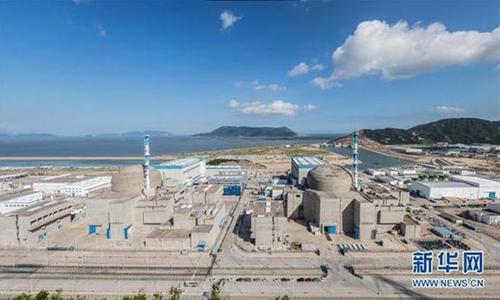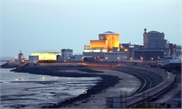UPDATE: China informs IAEA Taishan nuke plant operates well, no radiation release or environmental concerns
No leak at Taishan Nuclear Power Plant, no increase in environmental radiation limits: Officials

Photo:Xinhua
The International Atomic Energy Agency (IAEA) confirmed on Wednesday that it has received information from the China Atomic Energy Authority (CAEA), saying that there has been no radiation release and no environmental concerns in the Taishan Nuclear Power Plant in South China's Shandong Province.
In the notification to the IAEA, the CAEA said, "Unit 1 of the plant recently experienced a minor fuel rod cladding failure, which resulted in increased radioactivity in the unit's primary reactor coolant."
CAEA said to IAEA that the situation, a common phenomenon in nuclear power plant operations, was dealt with in accordance with accepted standards and procedures. According to on-site monitoring and an expert assessment, the unit's performance indicators, including the radioactivity of the primary reactor coolant, remain within the range of normal conditions and technical specifications.
Monitoring of the radiation environment around the Taishan Nuclear Power Plant shows that the radiation levels around the plant are normal, indicating there is no leakage at the plant, China's Ministry of Ecology and Environment (MEE) said on Wednesday, refuting CNN's report on an alleged leak and clarifying the concerned issues.
China's top nuclear safety regulatory hasn't approved any increase in the acceptable radiation limits around the Taishan plant, as CNN claimed in its report, according to the ministry.
The safety of the nuclear power plant is guaranteed, the ministry said.
It revealed that the specific activity (the amount of radioactivity contained per unit volume or weight) of the primary circuit reactor coolant in the Unit 1 plant was raised in the process of operations, but it still within the range that allows for stable operations, as specified in the technical specifications for the operation of the plant.
The elevated radioactivity level in the primary circuit of Unit 1 is mainly related to the damage of fuel rods. Due to the influence of uncontrollable factors in the process of fuel manufacturing, transportation and loading, a small amount of fuel rod damage is unavoidable, and it is a common phenomenon in the operation of nuclear power units, the MEE said. Many nuclear power plants around the world have experienced similar cases of fuel rod failure but continued operation, data showed.
There are more than 60,000 fuel rods in the reactor core of Unit 1 of the Taishan plant. It is estimated that about five fuel rods have been damaged, accounting for less than 0.01 percent of the total, which is far lower than the maximum fuel assemblies damage ratio (0.25 percent) in the design, according to the authority.
Moreover, the MEE stressed that the elevated radioactivity level in the primary circuit of Unit 1 is totally different from a radioactive leak accident. The primary circuit is inside the reactor. As long as the reactor coolant system's pressure boundaries and containment seals (that act as radioactive containment barriers) meet the requirements, there is no radioactive leakage to the environment. The two physical barriers are safe now, it said.
CNN reported on Monday that the "Chinese safety authority was raising the acceptable limits for radiation detection" at the plant to avoid shutting the plant down, citing a letter from French company Framatone, which partly operates the plant "to the US Department of Energy obtained by CNN."
The MEE refuted such claims and said that CNN used incorrect concepts in its report.
China's National Nuclear Safety Administration has not approved an increase in the acceptable radiation limits around the Taishan plant, the Chinese ministry explained. Instead, what the administration reviewed and approved were the relevant limits for the specific radioactivity of inert gases from reactor coolant in the primary circuit.
These limits are used for operation and management purposes, and are not related to radiation monitoring outside the plant, it said.
Data on China's real-time National Radiation Environmental Data Evaluation system showcasing the air absorbed dose rate, a measurement that can directly, rapidly and continuously reflect the environmental radiation level, also showed that there was no significant increase in radioactivity levels surrounding the plant.
On Tuesday, the air absorbed dose rate around the Taishan plant was 155 nGy/h (outdoor natural gamma dose rates), basically at a stable level as the average number in the fourth quarter of 2020 (157.2 nGy/h in October, 158.8 nGy/h in November and 160.9 in December), data showed.
Nuclear leakage can lead to a large, continuous increase in the absorbed dose rate of air. For example, as of the beginning of 2014, the rates at some stations still reached tens of thousands of nGy/h after the 2011 Fukushima nuclear accident in Japan, according to the website.
Since the Fukushima accident, the Chinese government has issued multiple documents, the core of which was to raise the safety level of its nuclear power plants.
In 2011, China suspended the approval of new nuclear power plant projects for a time after the Fukushima nuclear accident occurred. On October 24, 2012, China's State Council, the cabinet, passed the Nuclear Power Safety Plan (2011-20) and the Medium- and Long-Term Development Plan for Nuclear Power (2011-20). These documents required the resumption of nuclear power plant construction steadily, and they also raised the threshold: New nuclear power units must meet the third-generation safety standards.
In January 2016, China issued a white book on nuclear emergencies to establish a sound national nuclear emergency management system based on legal, institutional and institutional mechanisms.
The Taishan plant is using the third-generation Evolutionary Power Reactor technologies of France, which has higher safety standards compared with existing second-generation reactors, including French energy giant électricité de France's (EDF) own reactors, Lin Boqiang, director of the China Center for Energy Economics Research at Xiamen University, told the Global Times.
"I think all the benefits of nuclear power in China are based on safety. For the developers, safety is the lifeline. The loss would be incalculable if any incident occurred," Lin noted.
Notably, the Japanese government's response to the report was mocked by Chinese netizens and observers as "absurd" and "putting on sanctified airs," considering the government's irresponsible decision in handling the nuclear wastewater at the Fukushima plant.
Japan's Chief Cabinet Secretary Katsunobu Kato said at a news conference on Tuesday that he expected China to "provide a transparent and timely explanation to the world on the facts regarding the radiation leak report," although he also said no abnormalities had been reported at Japan's 47 monitoring posts, according to a report by Japanese media outlet NHK.
"Doesn't Japan know that the accident at Fukushima was a highest-level nuclear event? It now wants to confuse it with the normal operation of other nuclear power plants. Isn't it confounding right and wrong and acting shamelessly?" a netizen commented on Sina Weibo.
So far, multiple parties, including China's Foreign Ministry and the China General Nuclear Power Corp, the operator of the plant, have clarified that the units at the Taishan plant are running in a safe and stable situation.
Authorities from Hong Kong and Macao, which are close to the plant, said that the environmental indicators around the plant and its surrounding area are normal.
EDF said on Monday that it has ruled out the possibility of an accident, adding that radiation levels were within limits.
The MEE said that it will continue to closely monitor the radioactivity level inside the primary circuit of Unit 1 in the Taishan plant, and strengthen on-site supervision and environmental monitoring to ensure its safe operation.
It will also remain in contact with the IAEA and French nuclear safety regulators.

